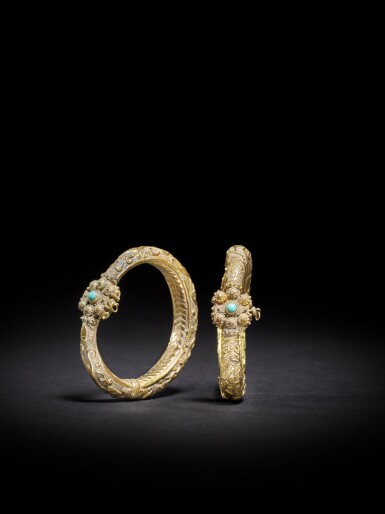
A pair of repoussé gold bracelets, Syria, 11th-12th century
Estimate
25,000 - 35,000 GBP
Lot Details
Description
of sheet gold, the inner loop with herringbone pattern, the outer loop with four running hounds and a vegetal pattern against a stippled ground, the hounds running towards a loosely heraldic motif of confronting birds, the clasp of six cylinders decorated with granules surrounding a single set turquoise
6.9cm. diam. each
The bracelets are part of a small group of closely comparable bracelets and armlets attributed to Syria (Jenkins and Keene 1982, pp.77-8; Vienna 1998, pp.119-125). Two of these bracelets are in the Metropolitan Museum of Art (inv. nos.58.37 and 1979.71), while two armlets are in the National Museum, Damascus (inv. nos.2842 and 2799). The latter armlet forms a pair with an armlet in the Freer Gallery (inv. no.F1948.25) and was excavated at Raqqa, anchoring the attribution.
While in many ways indebted to earlier and contemporary Iranian jewellery, a few technical qualities of the present bracelets identify them as part of this distinctive group attributed to eleventh- or twelfth-century Syria. In particular, the intricacy of the shank design, and the clasp design featuring the use of six cylinders topped by filigree granules and incorporating a single stone over the centre of the clasp are features unknown on Iranian bracelets but frequently seen in the Syrian group (Jenkins and Keene 1982, p.77). While the running sight hounds is a decorative motif with a wide reach and great longevity (cf. Metropolitan Museum of Art, New York, inv. no.2005.382), the confronting birds appear in similar configuration on wood carving in Fatimid Egypt (Vienna 1998, pp.81-85).
You May Also Like

![An extremely rare illustrated manuscript of the Ka'banameh (A history of the Ka'ba) by Abdulrahman Gubari (d.1566), signed by Ahmad [...] al-Khatib, Kaposvár, Hungary, dated Dhu'l-Hijjah 1080 AH/April-May 1670 AD](https://dam.sothebys.com/dam/image/lot/1e33ac28-a449-4673-a23f-f1ca4d5a13b3/primary/extra_small)








